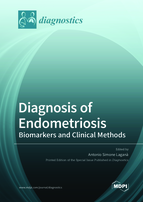Diagnosis of Endometriosis: Biomarkers and Clinical Methods
A special issue of Diagnostics (ISSN 2075-4418). This special issue belongs to the section "Pathology and Molecular Diagnostics".
Deadline for manuscript submissions: closed (31 August 2020) | Viewed by 47606
Special Issue Editor
Interests: women’s health; minimally invasive procedures; up-to-date management; gynecology; reproductive health; surgery
Special Issues, Collections and Topics in MDPI journals
Special Issue Information
Dear Colleagues,
Endometriosis is defined as the presence of endometrial-like endometrial cells, glands, and stroma outside the uterus, causing a wide range of symptoms and signs, including acute and chronic pelvic pain and infertility. Endometriosis affects approximately 10% of women in reproductive age, and up to 50% of infertile women. The etiopathogenesis of endometriosis still remains controversial: immune, hormonal, genetic, and epigenetic factors may be all involved, and several theories have been proposed to explain it.
One of the main problems for the management of endometriosis is the significant diagnostic delay: to date, several biomarkers are currently being tested in order to provide a reliable non-invasive diagnosis in case of symptoms and signs suspicious for endometriosis.
In addition, ultrasound techniques and magnetic resonance imaging are evolving rapidly, allowing for better accuracy, even with the use of artificial intelligence. Finally, new potential histological makers are helping to correlate the occurrence of endometriosis in different anatomical landmarks, supporting specific pathways to clarify the etiology of the disease.
This Special Issue will publish reviews and original research about the diagnostics of endometriosis: in particular, we welcome articles about molecular, cellular and histological biomarkers; imaging techniques, including ultrasound and magnetic resonance imaging, and new invasive (surgical) techniques.
Dr. Antonio Simone Laganà
Guest Editor
Manuscript Submission Information
Manuscripts should be submitted online at www.mdpi.com by registering and logging in to this website. Once you are registered, click here to go to the submission form. Manuscripts can be submitted until the deadline. All submissions that pass pre-check are peer-reviewed. Accepted papers will be published continuously in the journal (as soon as accepted) and will be listed together on the special issue website. Research articles, review articles as well as short communications are invited. For planned papers, a title and short abstract (about 100 words) can be sent to the Editorial Office for announcement on this website.
Submitted manuscripts should not have been published previously, nor be under consideration for publication elsewhere (except conference proceedings papers). All manuscripts are thoroughly refereed through a single-blind peer-review process. A guide for authors and other relevant information for submission of manuscripts is available on the Instructions for Authors page. Diagnostics is an international peer-reviewed open access semimonthly journal published by MDPI.
Please visit the Instructions for Authors page before submitting a manuscript. The Article Processing Charge (APC) for publication in this open access journal is 2600 CHF (Swiss Francs). Submitted papers should be well formatted and use good English. Authors may use MDPI's English editing service prior to publication or during author revisions.
Keywords
- Endometriosis
- Diagnosis
- Biomarkers
- Ultrasound
- Magnetic resonance imaging
- Invasive diagnosis







